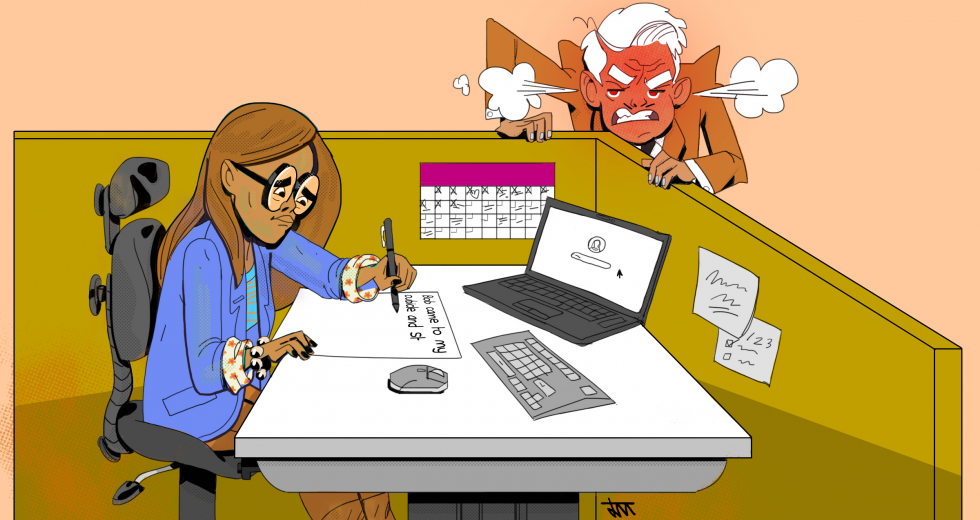Everyone always says if someone harasses you at work, make sure you document it, but what does that mean? Just write it down? Record the harasser with my phone? Do I get witnesses to write stuff? I have no idea how to go about this.
HR people often advise “Just document everything!” without telling you what that means or how to go about it. Here’s a quick guide to what you need to do when you’re documenting harassment.
Let’s start by addressing your question about recording the harasser with your phone. This seems like a great idea — proof that your harasser is harassing you! The only problem is that California is a two-party consent state. That means you can’t record a private conversation without the consent of everyone involved. The last thing you want is to get in trouble yourself!
So unless you’re willing to say, “Is it okay with you if I record this conversation?” then it’s not a great plan. Of course, if you’re meeting on a video conference that allows recording, it should give a message to all participants that the meeting is being recorded. You can ask the host for access to the recording or record the meetings yourself using an external device or a third-party screen recording software.
If you can’t record things, let’s talk about documenting. There’s no magic to it, and it doesn’t have to be perfect.
What documenting means
Documenting is a fancy word for writing something down. To have better documentation, use the following tips:
- Include date and time. If you’re documenting something that happened a few days or weeks ago, use your best guess, but note that it is an approximate date. You don’t want to lose credibility because you said, “Jane told a dirty joke on Tuesday,” and Jane can show she was out of town that day.
- Note what was said and done and by whom. Jane said this, and you responded with that. Then Jane did this, and you walked away.
- Include location. Was this at your desk? In the breakroom? Make sure you have the location.
- List any witnesses. Who else was there? Who walked by? If the person wasn’t there for the whole incident, still write the name down. If you don’t know the person’s name, write down what you know — “tan pants, blue shirt, male; I think he works in marketing.”
- Take a screenshot. If the harassment is online, take a screenshot and save it. Make sure that the username of the person who sent it is visible, as well as the time and date.
- Save pictures and videos. If you receive an inappropriate picture or video, save it and notify your IT and HR department immediately. You don’t want to get in trouble for not-safe-for-work content on your work computer, when it was really your harasser sending you an unwanted picture.
- Email your documentation. While some say to keep a running document or write things in a notebook, emailing is better. First of all, it gives a time and date stamp. Records are more credible closer to the incident. Second, unless it’s not against company rules, email it to your personal email address. If you get fired or the servers crash, you have a time and date-stamped record.
That’s it! That’s documenting! Just writing it down. Send it to yourself to establish the date. It’s ready when you want to make a complaint or ask for it.
But there are some pitfalls. Here are some don’ts.
- Don’t make value judgments or use pejoratives. It’s tempting to write, “George was a jerk. He said I could never succeed in sales!” Instead, just write, “George said I could never succeed in sales.” If you include the “jerk” part, George will insist that he was just joking, and your report will hinge on that.
- Don’t embellish. If George said, “Carol will never succeed in sales,” don’t write, “George said, “Women will never succeed in sales.” That’s a very different statement. You may have felt that is what he meant, but that’s not what he said.
- Don’t interview witnesses yourself. It can be tempting to gather people around you and get their stories, but don’t. Let the HR manager do the interviews.
When should you document?
If something egregious happens — like your boss says, “If you have sex with me, I’ll give you a promotion,” you should march directly to HR, your boss’s boss or an employment attorney. But most often, sexual harassment and other forms of discrimination are subtle.
If you’re in a situation where you feel like you’re being treated differently because of an immutable characteristic, such as race or gender, then documenting that can help clarify what is going on. For instance, you may think your boss constantly interrupts you because of your race, but careful documentation may show your boss interrupts everyone! A jerk, yes, but an equal opportunity one. Or it can show that, yes, your boss interrupts you and no one else.
Don’t spend your life documenting every interaction with your coworkers, but if something feels off, taking notes can help you to clarify what happened and identify patterns. For instance, in California, a hostile work environment requires harassment to be “present, severe, distracting to the victim’s job duties, physically threatening or unrelenting.” That last thing — unrelenting — is precisely the thing that regular documentation can prove.
So when someone tells you to document, that’s what you need to do! Keep it simple and do it as soon as possible after the incident.
–
Stay up to date on business in the Capital Region: Subscribe to the Comstock’s newsletter today.
Recommended For You

Dilemma of the Month: My Employee Is Lunching With a Player. Should I Warn Her?
An employer seeks answers about the ethics and boundaries of commenting on an employee’s personal life.

Dilemma of the Month: How Can I Attract Entry-Level Candidates Without Raising Pay?
An employer struggles with how to attract entry-level applicants without being able to increase their wages.

What Does the New Workplace Harassment Guide for California Employers Mean For Your Business?
Watch any news channel, listen to any talk radio station or read virtually any online news or social media feed, and chances are, you’ll learn about a new lawsuit being filed against a company based on allegations of harassment, discrimination or retaliatory conduct in the workplace.

Dilemma of the Month: He Said, She Said
We have a female employee who reported sexual harassment from a male coworker. The woman didn’t want to come forward, but once the CEO found out, he felt he had an obligation to handle the claim. We currently are without an HR manager. What is the proper way to handle this? Should an investigation be made?

Cyberbullies in the Workplace
Five ways to protect employees from virtual harassment
The emergence of remote work has broadened the horizons for
cyberbullying. We share the warning signs and five ways to
protect employees.

Dilemma of the Month: What should I do with an employee who won’t stop complaining?
A manager frustrated with an employee who frequently complains wonders if the problem lies with their management style, the team or the employee. Evil HR Lady offers perspective and potential solutions.




